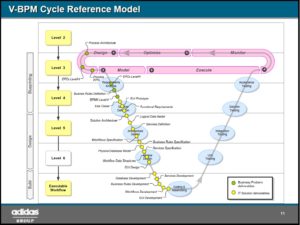Eduardo Gonzalez of the adidas Group talked about how they are implementing BPM within their organization, particularly the transition from business process models to designing a solution, which ties in nicely with the roundtable that I moderated yesterday. The key issue is that process models are created for the purpose of modeling the existing and future business processes, but the linkage between that and requirements documents – and therefore on to solution design – is tenuous at best. One problem is with traceability: there is no way to connect the process models to the thick stack of text-based requirements documents, and from the requirements documents to the solution modules; this means that when something changes in a process model, it’s difficult to propagate that through to the requirements and solution design. Also, the requirements leave a bit too much to the developers imaginations, so often the solution doesn’t really meet the requirements.
 The question becomes how to insert the business process models into the software development lifecycle. Different levels of the process model are required, from high-level process flows to executable workflows; they wanted to tie this in to their V-cycle model of solution design and development, which appears to be a modified waterfall model with integrated testing. Increasingly granular process models are built as the solution design moves from requirements and architecture to design and implementation; the smaller and more granular process building blocks, translated into solution building blocks, are then reassembled into a complete solution that includes a BPMS, a rules engine, a portal, and several underlying databases and other operational systems that are being orchestrated by the BPMS.
The question becomes how to insert the business process models into the software development lifecycle. Different levels of the process model are required, from high-level process flows to executable workflows; they wanted to tie this in to their V-cycle model of solution design and development, which appears to be a modified waterfall model with integrated testing. Increasingly granular process models are built as the solution design moves from requirements and architecture to design and implementation; the smaller and more granular process building blocks, translated into solution building blocks, are then reassembled into a complete solution that includes a BPMS, a rules engine, a portal, and several underlying databases and other operational systems that are being orchestrated by the BPMS.
Gonzalez has based some of their object-driven project decomposition methods on Martyn Ould’s Business Process Management: A Rigorous Approach , although he found some shortcomings to that approach and modified it to suit adidas’ needs. Their approach uses business and solution objects in an enterprise architecture sort of approach (not surprising when he mentioned at the end of the presentation that he is an enterprise architect), moving from purely conceptual object models to logical object models to physical object models. Once the solution objects have been identified, they model the object states through its lifecycle, and object handling cases (analogous to use cases) that describe how the system handles an object through its full lifecycle, including both system and human interaction. He made the point that you have to have the linkage to master data; this is becoming recognized as a critical part of process applications now, and some BPMS vendors are starting to consider MDM connectivity.
The end solution includes a portal, BPMS, BRMS, ESB, MDM, BI and back-end systems – a fairly typical implementation – and although the cycle for moving from process model to solution design isn’t automated, at least they have a methodology that they use to ensure that all the components are covered and in synchronization. Specific models at particular points in their cycle include models from multiple domains, including process and data. They did a proof of concept with this methodology last year, and are currently running a live project using it, further refining the techniques.
Their cycle currently includes the model and execute phases of a standard BPM implementation cycle; next, they want to take on the monitor and optimize phases, and add modeling techniques to derive KPIs from functional and non-functional requirements. They also plan to look at more complex object state modeling techniques, as well as how adaptive case management fits into some of their existing concepts.
I posed a question at the end of my roundtable yesterday: if a tool existed that allowed for the definition of the process model, user interface, business rules and data model, then generated an executable system from that, would there still be a need for written requirements? Once we got past the disbelief that such tools exist (BPMS vendors – you have a job to do here), the main issue identified was one of granularity: some participants in the process modeling and requirements definition cycle just don’t need to see the level of detail that will be present in these models at an executable level. Obviously, there are still many challenges in moving seamlessly from conceptual process models to an executable process application; although some current BPMS provide a partial solution for relatively simple processes, this typically breaks down as processes (and related integrations) become more complex.
